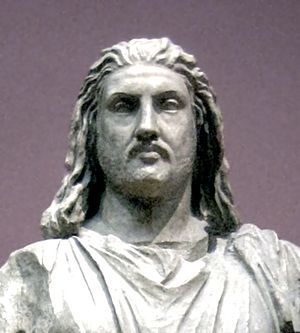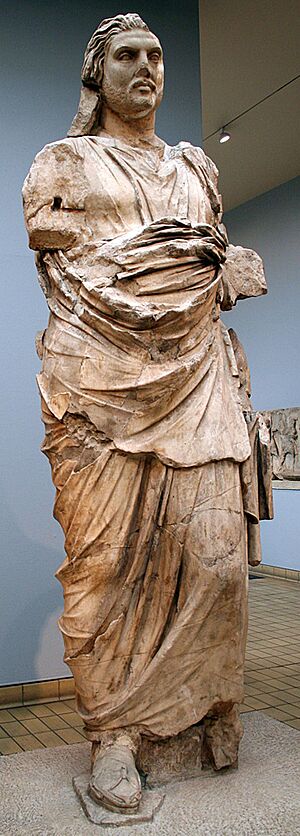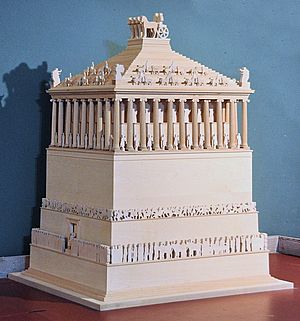Mausolus facts for kids
Quick facts for kids Mausolus |
|
|---|---|

Mausolus, 377–353 BCE. Casting from the Pushkin museum.
|
|
| Satrap of Caria | |
| In office | 377–353 BCE |
| Predecessor | Hecatomnus |
| Successor | Artemisia II |
| Born | Caria (modern-day Turkey) |
| Died | 353 BCE Halicarnassus, Caria, Achaemenid Empire (modern-day Bodrum, Muğla, Turkey) |
| Burial | Mausoleum of Halicarnassus |
| Consort | Artemisia II |
| House | Hecatomnids |
| Father | Hecatomnus |
Mausolus was a powerful ruler of Caria, a region in ancient Anatolia (modern-day Turkey). He ruled from 377 to 353 BCE. Mausolus was also a satrap, which was like a governor, for the huge Achaemenid Empire (the Persian Empire).
He became very powerful because of his father, Hecatomnus, who was the first satrap from their family, the Hecatomnid dynasty. Besides Caria, Mausolus also controlled other areas like Lycia and parts of Ionia and the Dodecanese islands. He is most famous for his amazing tomb, the Mausoleum at Halicarnassus. This tomb was so grand that it became one of the Seven Wonders of the Ancient World. It was traditionally built by his wife and sister, Artemisia.
Contents
What's in a Name?
Mausolus' name comes from the Carian language, which was spoken in his home region. It might mean "much blessed." The first part, Ma-, could mean "much," and -uśoλ means "blessed." This "blessed" part was a common ending in Carian names.
Early Life and Becoming a Ruler
Mausolus was the oldest son of Hecatomnus. His father was a native Carian who became the satrap of Caria around 395-392 BCE. Mausolus took over as ruler when his father died in 377 BCE. Some historians think they might have ruled together for a few years before Hecatomnus passed away. Their close bond was shown in family artworks, like scenes from Hecatomnus' tomb.
Mausolus' Reign

Mausolus became satrap after his father's death in 377/6 BCE. He ruled alongside his wife, Artemisia, who was also his sister. Even though only Mausolus was officially called "satrap," Artemisia clearly had political power and ruled with him.
The Satraps' Revolt
Mausolus was involved in a series of rebellions called the Revolt of the Satraps. This was a long and complicated time when many governors in the western part of the Persian Empire rebelled against King Artaxerxes II Memnon.
Mausolus mostly supported King Artaxerxes. However, some Greek writers said he also briefly rebelled. For example, he helped besiege a city called Adramyttium for the King. But then, he was supposedly convinced by a Spartan king, Agesilaus II, to abandon the siege. This might show that Mausolus sometimes secretly went against the King, but he never openly fought him.
Unlike other rebels who were punished, Mausolus was not. He stayed in power after the revolt ended in 362/1 BCE. He was even rewarded with control over Lycia, a region to the southeast of Caria.
Ruling Lycia
After the Satraps' Revolt, Mausolus and Artemisia added Lycia to their territory. Before this, Lycia had been ruled by local leaders. Mausolus didn't conquer Lycia, but he became its new satrap. From then on, Lycia stopped making its own coins and instead used coins from Mausolus and his family.
Mausolus and Artemisia also made an alliance with Phaselis, a city on Lycia's eastern border. This showed how far their influence reached.
The Social War
Mausolus and Artemisia also got involved in the Social War (357–355 BCE). In this war, they supported cities that were rebelling against Athens. By doing this, they helped spread their power to Greek islands and cities near Caria.
A Greek speaker named Demosthenes said that Mausolus was the main person who encouraged the rebellion against Athens. It seems Mausolus wanted to expand his influence over nearby Greek islands like Rhodes, Cos, and Chios.
The Social War ended quickly in 355 BCE. Athens was weakened, and the Persian King Artaxerxes III stepped in to set the peace terms. After the war, Mausolus and Artemisia gained control over Rhodes, Cos, and Chios.
Mausolus also took control of parts of Ionia at different times. He and Artemisia had a lot of power over Greek cities on the coast of Caria, like Iasos and Miletus. They sometimes used clever tricks to enforce their rule. For example, Mausolus once tricked the people of Latmus by pretending to return hostages, then ambushing the city when everyone came out to watch his procession.
A Powerful Ruler's Reputation
Mausolus was not always popular with everyone he ruled. Some ancient Greeks saw him as a very powerful ruler who sometimes used tricky ways to get what he wanted. For example, it was said that he once told the people of Mylasa that the Persian King was going to attack their city. He asked them for money to build walls, but then kept the money and didn't build the walls, because the city was never attacked.
Another story tells how one of his deputies, Condalos, tricked the people of Lycia. He told them the King needed their hair for horse wigs! He said if they didn't want to shave their heads, they could pay money instead. This was a trick, and Mausolus and Condalos made a lot of money.
Not everyone accepted his rule easily. There were even attempts to assassinate Mausolus during his reign. These plots show that some people were unhappy with his strong control.
Grand Building Projects
Mausolus and Artemisia moved their capital from Mylasa to Halicarnassus early in their rule. Halicarnassus was a Greek city with many Carian people. Mausolus rebuilt the city with a new layout. He also brought people from nearby Carian villages to live in the new capital, making it much larger.
The new Halicarnassus had many Greek features, like a large theatre and a public meeting place called an agora. New city walls were built, and the harbor was improved, making Halicarnassus an important port for their navy. They also built a palace for themselves.
Mausolus also rebuilt important Carian religious sites in the mountains, like Amyzon, Labraunda, and Sinuri. These places had new, grand temples. The annual procession to Labraunda from Mylasa became a very important event for the Hecatomnid family.
Greek Culture and Art
Mausolus was very interested in Greek culture. He sponsored a special style of art and architecture called the "Ionian Renaissance" throughout his lands. Many cities and religious centers in Caria show this beautiful Greek-inspired style because of his support.
The Mausoleum at Halicarnassus
Mausolus is most famous for his incredible tomb, the Mausoleum at Halicarnassus. It's said that his wife and sister, Artemisia, built it for him after he died. However, it's likely that construction started while Mausolus was still alive, and he helped oversee it.
The Mausoleum was a mix of Greek and Anatolian building styles. Famous Greek artists and architects worked on it, including Satyrus, Pythis, Scopas of Paros, Leochares, Bryaxis, and Timotheus.
This tomb was so famous that the word "mausoleum" (which comes from Mausolus' name) is now used for any large, impressive tomb built above ground. The ancient writer Antipater of Sidon listed it as one of the Seven Wonders of the Ancient World.
Today, you can still see the site of the Mausoleum and some remains in the Turkish town of Bodrum (which was ancient Halicarnassus). Many of the surviving sculptures are now in the British Museum.
Mausolus' Death
Mausolus died in 353 BCE, shortly after an assassination attempt. It's not known what he died from. His remains were placed in the Mausoleum at Halicarnassus, which he and Artemisia had been building. People continued to honor Mausolus at his tomb for many years after his death.
Artemisia held a very grand funeral for Mausolus, with games and ceremonies. Many famous Greeks attended. This is why Artemisia became so well-known for her deep grief.
Mausolus and Artemisia did not have any children. After Mausolus died, Artemisia ruled alone for a short time. Then, her brother Idrieus and sister Ada took over, and they were also married to each other.
Centuries later, a writer named Lucian of Samosata wrote a story where Mausolus, even though he was rich and powerful in life, was teased by a philosopher in the afterlife because they both ended up with nothing after death.
Images for kids
-
Coinage of Maussolos as Achaemenid satrap of Caria. Head of Apollo facing, Zeus Labrandos standing, legend MAYΣΣΩΛΛO ("of Mausolus"). c. 377/6 – c. 353/2.
See also
 In Spanish: Mausolo para niños
In Spanish: Mausolo para niños




